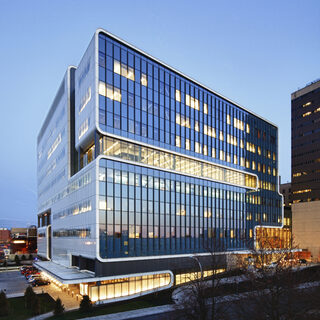Tradeline's industry reports are a must-read resource for those involved in facilities planning and management. Reports include management case studies, current and in-depth project profiles, and editorials on the latest facilities management issues.
Latest Reports
1183 Jelke BSL-3 Lab
Spurred into action by a broken autoclave, Rush University Medical Center gutted and rebuilt its 30-plus-year-old BSL-3 lab and its anteroom, while converting existing adjacent offices into a dedicated mechanical room. The primary goals with the renovation were to bring the lab up to contemporary BSL-3 standards and to isolate its infrastructure and utilities from the rest of the Jelke Building, a mixed-use lab and patient-care building.
Kaleida Health/University at Buffalo Facility Represents New Era in Collaboration
The Gates Vascular Institute (GVI) transforms the concept of translational collaboration, uniting not only a private health entity with a public institution, but also patients, physicians, researchers, educators, industry, and government within a state-of-the-art vertical campus. The building brings together, through a unique public/private partnership, the heart, vascular, and emergency facilities of Kaleida Health; the Clinical Translational Research Center (CTRC) of the University at Buffalo (UB); and a biosciences incubator and The Jacobs Institute of Neurology, both UB affiliates.
Saint Louis County Health Campus
The two-story, 93,455-sf Saint Louis County Health Campus replaces and consolidates two facilities: the old headquarters and the John C. Murphy Health Clinic, which was located on the site. The first floor houses the vital records office, as well as the Murphy Health Center. The clinic includes women's health, pediatrics, dental, WIC, nutrition, X-ray, and clinical labs. The modern, spacious facility also houses health education, with three community classrooms and a larger community room. The Chest Clinic has a separate entrance on the west side of the building.
Structural and Materials Engineering Building
The 183,000-sf Structural and Materials Engineering Building at UCSD houses several engineering departments, including Structural Engineering and NanoEngineering, as well as the Department of Visual Arts. Inspired by Bauhaus principles, the building's design fosters interaction between arts and engineering disciplines through gathering spaces, communal circulation, and shared computer and research laboratories. Offices are grouped around a variety of open meeting spaces to enhance collaboration while maintaining privacy.
Agile Workplace Design Helps Businesses Achieve Their Goals
Creating an "agile workplace"—by determining the overall business goals of an organization, making an in-depth appraisal of how employees work, and creating an efficient, cost-effective workspace that satisfies various work requirements—can save money in the long run by providing a satisfying workplace designed around employee's work activities.





